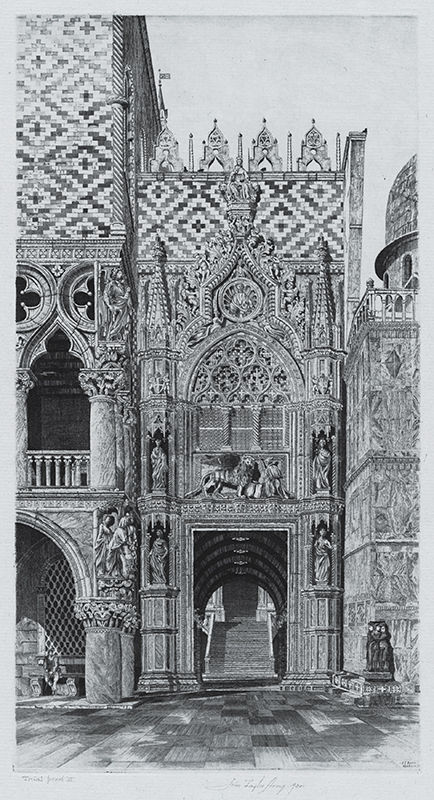
19th, 20th & 21st Century Fine Prints
707-546-7352 · fax 707-546-7924 · web: www.annexgalleries.com · email: artannex@aol.com
The Enchanted Doorway; a.k.a. La Porta Della Carta, Venezia by John Taylor Arms

The Enchanted Doorway; a.k.a. La Porta Della Carta, Venezia
John Taylor Arms
The Enchanted Doorway; a.k.a. La Porta Della Carta, Venezia
John Taylor Arms
1887 - 1953 (biography)Porta Della Carta is a Venetian ceremonial doorway created by Giovanni and Bartolomeo Bon in the 15th century. It connects the Doge’s Palace with the south wall of St. Marks Basilica. Porta Della Carta is considered an exquisite example of Late Gothic style architecture, and includes a sculpture of the Doge Francesco Foscari kneeling before the lion of Saint Mark. The original sculptures of Foscari and the lion were destroyed in 1797 by the Napoleonic fury. Originally the entire gateway was painted and gilded.
John Taylor Arms captures the intricate carvings of the entrance of doorway, whose name translates to the Paper Portal, in reference to its proximity to the palace’s archives. The 15th century Late Gothic entryway holds symbolic elements throughout, captured in minute detail by Arms down to the glass rondels in the window, and the faces of the Four Virtues. Adding interest to this small section of the palace is the Moorish brick patterning along the top half of the facade, evidence of Venice’s long and varied history as a hub of international commerce. Arms was no doubt taken with this slice of historic architecture, judging by the name he gave the etching.
John Taylor Arms, printmaker, lecturer, illustrator, and administrator, was born in Washington, D.C. on 19 April 1887. He first studied law at Princeton University but transferred to the Massachusetts Institute of Technology to study architecture, earning a Master’s Degree in 1912. He studied with Ross Turner, David A. Gregg, and Felton Brown. For five years after his graduation Arms worked for the architectural firm Carrere and Hastings, before establishing his own architectural firm of which he was a partner.
A gift of an etching kit from his wife, Dorothy, changed the course of his life. He produced his first etching in 1915 and he eventually produced 441 prints, mostly etchings. Arms became one of the most famous printmakers of the first half of the twentieth century. He is mostly noted for his etchings of medieval architecture but early subjects also included ships, sailboats, airplanes, rural landscapes, and the streets, buildings, and bridges of New York.
Arms’ exhibition history was lengthy beginning in 1927 and continuing to 1952. He authored 'Hand-Book of Print Making and Print Makers' in 1934 and illustrated 'Churches of France' and 'Hill Towns and Cities of Northern Italy' by his wife, Dorothy Noyes Arms. His work can be found in most major collections of American prints.
Arms was an activist for printmaking and assisted in assembling exhibitions of American graphic art that were shown in Sweden, Czechoslovakia and Rome; he was editor of the Print Department of Print, A Quarterly Journal of the Graphic Arts, and he lectured on the techniques, history and value of original prints. Arms also served as the president of the Tiffany Foundation in 1940. John Taylor Arms died in New York City on 15 October 1953.


